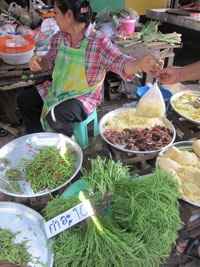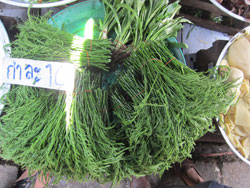By Hoihnu Hauzel
Note: This article was originally posted on June 4, 2011 at Down to Earth.
Hoihnu Hauzel explores the similarities between Thailand and India’s northeastern part

I remember my maiden trip to Thailand eight years ago. Tears welled up my eyes for reasons unknown. Was it the feeling of excitement to be a part of a larger group or was it the sight of those Thai ladies sitting in supermarket stores and eating their lunch; a portion of short-grain sticky rice with what looked like a side dish and soup that reminded me of home. Like us in the Northeast of India, they would first put the rice into their mouth followed by a small helping of the side dish. Then wash it down with soup.
Later, at a busy vegetable market it was all the green vegetables and herbs that brought another gush of excitement. It was then that I asked myself this question: If people living in two different worlds eat the same food, how different could they be?
Researchers, scholars and anthropologists have written heaps on the cultural linkages between southeast Asia and India’s Northeast but to actually see these linkages in real and live them was an emotional experience.
And so the first thought that came to mind was where have we lost the link? Or, where and when in history did we part ways to be so many miles apart yet so close. This time round, it was the same feeling that overwhelmed me. There I was at a busy vegetable market doing my usual round of looking at the vegetables even though I wasn’t buying anything. It was my way of exploring any city. I would go to vegetable markets in places like Barcelona, Paris, San Francisco and Beijing.
The vegetable market on the railway track in Samut Songkram province, about 70 km southwest of Bangkok, is called Mae Klong. It has all the ingredients of what I would call a local market in any part of Northeast. It could have been in Shillong’s Bara Bazaar, or Kohima’s super market where Naga women sell all kinds of freshly-plucked herbs and vegetables.
The Thai women brought all kinds of fresh produce from the farm. There was sun-dried fish, seafood and meat. Like the people in northeastern part of India, the Thais love dried fish which is an important ingredient for a side dish called nam phrik. Nam phrik is a hot sauce prepared with shrimp paste and chilli sauce like the malta meh or Naga chutney or what Meitei’s called morok met pah.
In rows of basket, I saw sun-dried shrimps, river fish and eel. These are relished by people in the Northeast who cannot do without their dry fish. Smoked eel is so popular in Meitei’s morok petpa which is a spicy chutney made of smoked eel, roasted chillies and tomatoes and garnished with fresh coriander. My first eel chutney was at my Tangkhul uncle’s house when I was a little girl.

Then there was what the Meitei’s in Manipur called tham chet or a water plant that is usually used for salad and chutney. The Thai stir fry it and relish with rice. Needless to say, rice is another common thread that binds us.
I was equally amused by the very nature of the market itself. A two-carriage train travels between Baab Laem station and Mae Klong station eight times a day. This means each time the train passes through the track vendors would clear their things in a hurry and put them back once the train passes through.
As I went beyond Bangkok, at a faraway craft village in Chiangmai, I realised that our linkages go beyond food. In that make-shift model village are different tribes like Lisu, Karen and Lahu. They live in thatched roof homes much like the tribes in Northeast. I saw a Karen woman weaving. Her weaving tool wasn’t any different from what I saw in Manipur. A Lisu man weaving a cane basket reminded of my late paternal grandfather who was good at almost everything that needed skill. My late grandpa loved weaving basket of cane and bamboo. I also saw a Lahu woman in her colourful customary gear making beaded necklace. The colour of her beads and the motifs she chose to weave on those bracelets weren’t too different from what the people in the Northeast would do to make their ornaments.
One evening as I escaped the sightseeing routine and decided to sit back at Siam Niramet, an entertainment centre that showcases Thailand’s art and cultural heritage. I was only reaffirmed of the cultural bond. There are makeshift houses of different Thai tribes. Some thatched roof houses have cane baskets that are beautifully woven just like what people in the Northeast carry when they go to their rice fields. The basket is referred differently by different tribes. The Paites in Manipur would call these baskets seng. Even the wooden giant Mortar and pastle only suggests that just like the people of Northeast, the Thai tribes took to crushing their grains manually.
The cultural performance that was peppered with elaborately designed costumes and stunning gadgets had unmistakable elements of the Northeast. In their elaborate dance movements, I saw Raas Leela, Mizo Bamboo dance, Assamese bihu and Naga dance. After the show, I hit the street hungry and ate to my heart’s content sticky rice with chicken fried with ginger and garlic.
